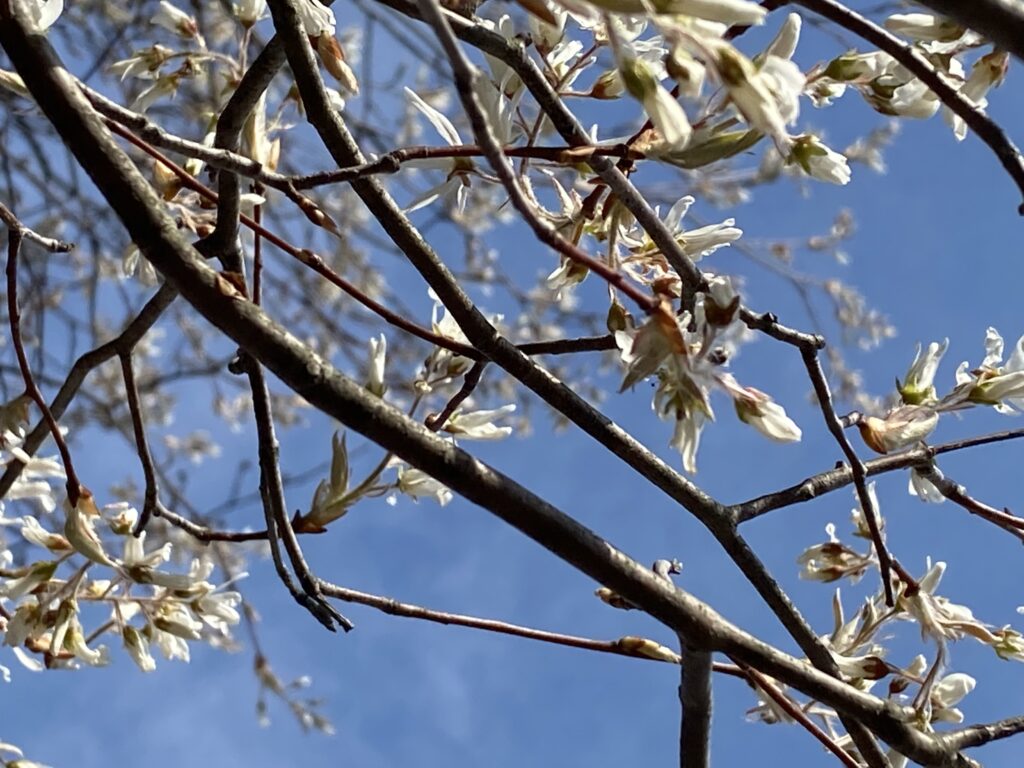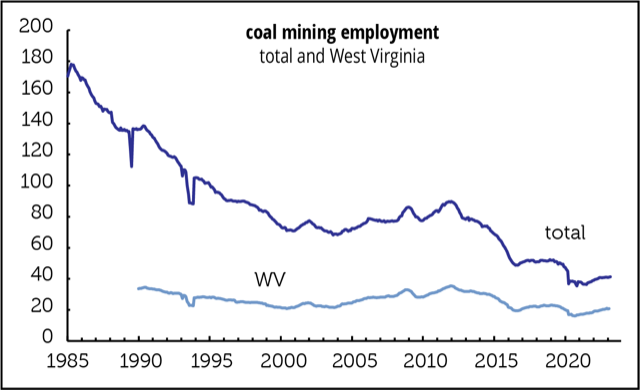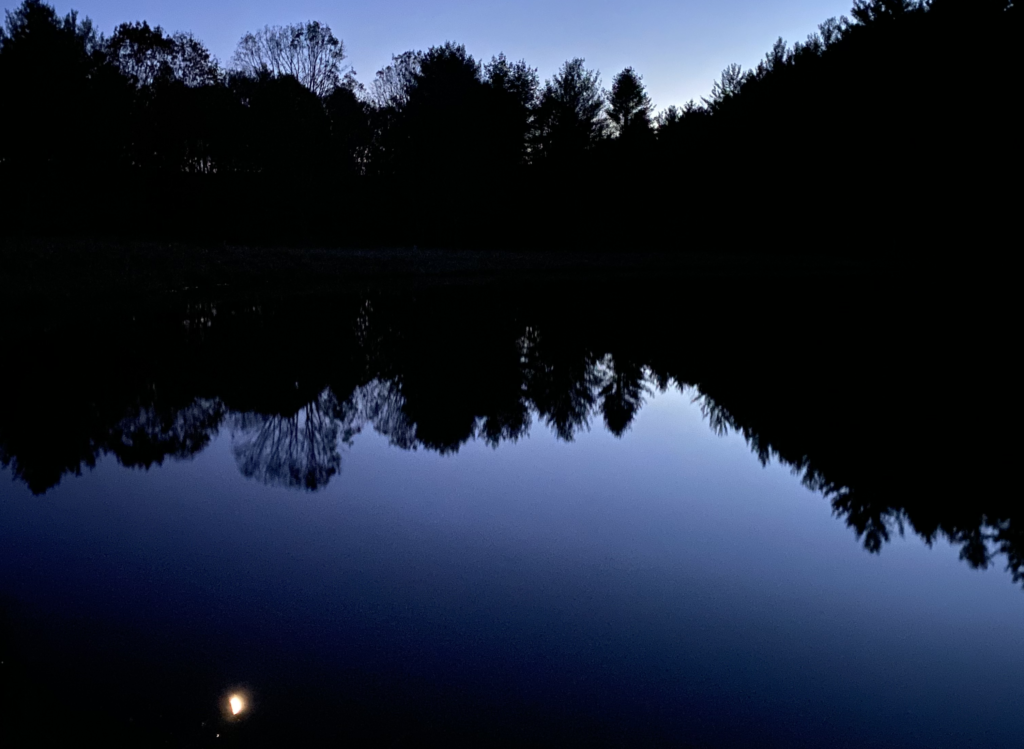Coal Country, Shadblow, and Spring
We’ve written about the sophistication and inclusion of coal-mining communities in their early days, of land theft, empty promises, and hopes that were revised away. In a new NBER working paper, Canary in the Coal Decline, Josh Blonz, Brigitte Roth Tran, and Erin E. Troland—the first and last of the Federal Reserve, the second of the San Francisco Fed—report on the broad effects of the decline in coal mining on household finances in Appalachia. Removing coal from our energy mix is a top priority if we want to clean up our energy act; everything about it is enormously filthy, from mining it to burning it. But what are the human costs of the transition away from it?
To answer those questions, the authors use data from the New York Fed/Equifax panel, which is the same source as the New York Fed uses in its consumer credit series. They look at important measures of household economic well-being between 2011 and 2018—a period when total employment in the industry fell by 43% as total employment rose 11%—in counties with a heavy concentration of coal mining. Here’s a long-term look at coal employment:
Coal-rich Appalachia has long been one of the poorest parts of the country, with relatively low educational attainment by national standards, a gap that has been widening. A good bit of the reason for this is that coal has been in decline for far longer than the last decade or two—it’s more like a century. Coal has become progressively less competitive economically compared to natural gas, as both plant construction and extraction costs have fallen (thanks to fracking, which won’t win any environmental awards either).
Even though coal accounted directly for only 2% of employment in what they define as active coal-mining counties, the economic impact of the decline was much broader and more severe than that small share would suggest. For example:
• Credit scores in coal-intensive regions were about 3 points lower than they would have been otherwise. That may not sound like much, but other researchers have found that even a 1-point decline can be economically meaningful. The effects went well beyond the 40,000 miners who lost jobs nationally over that seven-year period (three-quarter of them in this survey area). The effects were concentrated among those in the bottom half of the credit-score distribution. At the 40th percentile, roughly at the cutoff for subprime classification, the credit score hit was 7 points.
• Those credit score declines translated into a 50-basis point increase in mortgage interest rates.
• Declines in coal demand resulted in increases in the share of households ranked as subprime, more intensive use of credit cards, higher delinquencies and collection rates, and more entries into bankruptcy.
• Damage was felt most in the second-lowest quartile of credit scores—in other words, people were on the verge of falling into serious hardship. But even those in the top quartile take a hit—a small one, but evidently no one is safe from the contraction in coal country.
• None of these findings are driven by age.
As the authors note in their conclusion, these finding are a warning about what might happen in other fossil fuel producing communities as carbon-based energy sources recede in importance. They don’t note, but we will, that the political effects of this impoverishment can be harsh, underscoring the need to insulate affected regions against the harms coming from an essential energy transition.
Case study
A footnote to the above: a closer look at the state most closely identified with coal (both by outsiders and residents), West Virginia.
Having such a coal-centric economy has not been kind to the state. West Virginia has the second-lowest employment/population ratio (EPOP) in the country, 52.6%, just behind South Carolina and above dead-last Mississippi. That’s 7.6 points below the national average and 15.2 points below the leader, Nebraska. Even at the peak in the national EPOP, 64.7% in April 2000, it was turning in a miserable 52.8%.
West Virginia has the fifth-highest poverty rate, 15.0%, 3.8 points above the national average and nearly three times the state with the lowest rate, New Hampshire, 5.6%. Coal made a lot of people rich over the decades—just not ordinary West Virginians.
That’s why transformative work being done by outfits like the Ohio River Valley Institute is so important, as are targeted programs like the Hickman Holler Appalachian Relief Scholarship, founded by musicians Senora May and her husband Tyler Childers, to provide scholarships to regional schools like Morehead State University. MSU is known for its STEM programs, and HHARS is giving priority to African-American students. Regional farmers’ markets too.
Philippa Dunne & Doug Henwood
Shadblow, one of many popular names for Amelanchier, was once one of the first trees to bloom in the Appalachian spring.







Logic Check from Bird World
Conservation scientist J. Christopher Haney, who was brought in by Fish & Wildlife to lead the largest study of pelagic birds in the Gulf Coast in the aftermath of the Horizon blowout, likes to count. In his recently released book, “Woody’s Last Laugh, How the Ivory-Billed Woodpecker Fools Us into Making 53 Thinking Errors,” he documents a hundred years of flawed thinking and makes some broad suggestions, an encouraging read in this time of loud, angry voices.
Many species facing extinction get little play in the press. Not so the Ivory-billed Woodpecker (IBWP): A putative spotting in the Big Woods of Arkansas in 2004/5 generated over 450 media reports, and arguments about the status of the species are often as acrimonious as current political dust-ups. As many know, the US Fish and Wildlife Service declared the species officially extinct seven months ago, despite persistent claims of sightings that continued after the announcement.
Haney admits that he chuckled in a snarky way when he read the F&WS announcement, not because extinction is funny, “it’s deadly serious,” but because, Here we go again….
In his younger years, Haney considered the extinction of the nomadic Ivory-billed Woodpecker (IBWP) a resolved issue, and concentrated on other questions. He admits that the status of the IBWP was never a big deal to him. He thinks of the species as a “big black, white and red woodpecker,” of which we have another so alike it is hard to distinguish, the pileated woodpecker. But eventually he was drawn in.
Haney’s father was a book salesman, and gave his young son many 19th century bird books, mostly seconds, that Haney read carefully. In the hoopla following the possible IBWP sightings some time ago, he found that the bird being described in the newspapers in the early aughts bore no resemblance to the bird described by naturalists in 1873. Yet the real tipping point for his thinking was driven by his observations of how people responded to the reports, and he embarked on a ten-year study of that phenomenon.
He hypothesizes that we have a “pig-headed death wish” for the bird because it does not conform to our expectations, and that this began in the late 1800s just as the US frontier was closing, causing the American public to engage in a lot of myth-making tied to the wilderness.
The somewhat incomprehensible errors that pushed the bird toward a “symbolic grave” began in the 1930s, when UT Knoxville ornithologist James Tanner saw them eating large grubs in pristine old growth forests. Those forests were “felled to the wartime ax” in the 1940s, and ornithologists decided the species could not adapt and would be forced into extinction. (People thought this about the similar pileated woodpecker around the same time.) Tanner did not follow the bird, which may be or have been an opportunistic wanderer. And importantly, his belief that they could only survive in virgin bottomland hardwoods was directly contradicted by a photograph taken by his own mentor showing a pair in piney flat woods, with a female on the ground—which supposedly doesn’t happen—amid scrawny trees.
There’s a lot in the book, but we’ll cut to a few of the biases Haney outlines, harking back to the work of Kahneman and others on our thought processes, always good reminders.
Anchoring bias, we have been anchored to the belief the bird is likely extinct for one hundred years, largely because of misconceptions about its diet. Haney points out that a bird so narrow a specialist would never have survived into the modern era, referencing the waves of extinctions that killed off 34 mammal genera over the years.
We often get extinctions wrong. We’ve re-found over three hundred species that were once believed extinct over the last hundred years, and we tend to rush to a belief in extinction rather than to a default that the species is alive somewhere. The Bermuda petrol, a sea bird of similar size, was listed as extinct in 1620, but in fact populations in the low single digits managed to hide out in the open terrain of Bermuda’s tiny islands to be rediscovered 300 years later. This is the Romeo bias, the serious error that led Romeo to kill himself when he believed Juliet was dead. Listing the ivory-billed as extinct takes it out of field guides, and makes it less likely that people will be able to identify individuals if seen, which will limit our understanding. In addition, the extinction stamp removes protections from potential habitats.
Haney makes the stunning observation that we take all sight reports before 1915 at face value and accept them, yet between 1915 and 1940 they became controversial, and every observation after 1940 has been attacked. He points out that in the 1800s observers were riding on horseback through tough terrain, without binoculars, while more recent observations benefit from excellent optics, lots of field guides, and “a cohesive birding fraternity unafraid to levy ruthless verdicts from doubting peers.” That we have changed our criteria across historic eras, essentially dismissing a whole class of people because they are “suggestable,” reflects fundamental attribution error. And it only goes in one direction: people are believed to have mistaken a pileated for an ivory-billed, never the other way around. There have been over a hundred sightings through the final decades of the 20th and into the early decades of the 21st centuries, which Haney considers important.
The math supports Haney’s view that we don’t know. He argues that we would have to send observers into every one of the 90,000 acres where the IBWP was once seen 254 times to be 99% sure it is not there. Even if there are as many as 500 birds remaining, sprinkled throughout ten southern states, the probability of seeing one is not zero but close to. A prior study costing $1.6 million got through only 12% of the territory, and was abandoned, with analysis suggesting if there were 100 birds a very poor sighting might occur every 2 years, but even a blurry photograph would probably take 20.
Haney closed one interview by noting that birders generally only accept indisputable sightings—“A 70% probability may be OK for stock-picking,” but not for science. But he calls keeping lists only of verified accounts nothing but a limiting hobby, and that hobbies are not “granted the final word on truth,” as we search of what is reliable in our universe. The IBWP described in ornithological science is not the same as the birders’ IBWP, we have to look at the math, look at the social identities of those arguing for and against—for example, southern hunters might want to keep federal regulators off their hunting grounds—and perhaps give some credence to recent sight reports. He suggests the safest thing to do is back away from this mind trap and say, “I don’t know,” a useful three words, if seemingly easier to say by those with broader knowledge.